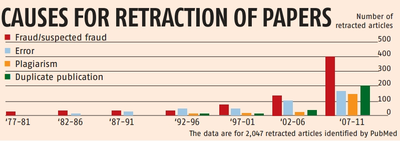Building Up vs Tearing Down
We have to find ways to deal with corruption without subverting our developmental aims.
This article by Shyam Ponappa originally published in the Business Standard on July 3, 2013 was also mirrored in Organizing India Blogspot
Many economies around the world are in an unenviable state. India too has lost another chance at breaking out of its self-limiting mould of haphazard divergence and fractious irresponsibility. These constraints are exemplified by the ruling party's overindulgence in populist and crony handouts, such as ill-considered Mahatma Gandhi National Rural Employment Guarantee Act or food security initiatives, or the latest gas pricing decision, apparently without any sense of responsibility for the detrimental consequences, including for cash flows. The sole criterion is to somehow stay on top. Alas, they are matched by the unmitigated confrontationism of a flailing Opposition. As a consequence, we remain a land of unrealised potential, our energies focused on hindering or tearing down instead of building up. Lack of credible enforcement is hampering development, and the two are becoming mutually exclusive.
To a considerable extent, the troubles worldwide, including our own, appear to have resulted from excesses of some sort, whether of dishonesty or destructive activism. Is a sense of decline because of the economic downturn, or are there genuine negativities in our times? Is there an inevitable slide to dishonesty, as Plato concluded - reaffirmed in more recent works across cultures, such as Corruption Cycles by Cristina Bicchieri and John Duffy? [1]
The distribution of personal attributes in any large set of people ensures that there will always be some who will try to cheat, even in the elevated domain of scientific research. A consideration of two instances, one global and the other local, may provide some indicators.
Misconduct in Research
Consider the retraction of scientific papers. The title of a report published in October 2012 says it all: "Misconduct Accounts for the Majority of Retracted Scientific Publications". [2] First, there has been a rising trend in the 2,047 retractions since the first in 1977 (there's a puzzling caveat about retractable offences not being necessarily new). Second, the rise since 1977 has been almost tenfold. Third, over two-thirds were attributable to misconduct, including intentional falsification or fabrication of data. Almost half of all retractions (43 per cent) were for fraud, suspected or actual; duplicate publications were 14 per cent, and plagiarism almost 10 per cent. The report concludes that for articles for which the reason for retraction is known, three-quarters were for actual or suspected misconduct, while errors accounted for only a quarter (Chart 1).
Chart 1
 |
|---|
Geographic Spread
Of the retracted articles from 56 countries, three-quarters of fraud or suspected fraud were from the United States, Germany, Japan, and China. India's share in plagiarism and duplicate publication is relatively high; its share in fraud, also relatively high, is lower than in the other two (Chart 2).
Chart 2
 |
|---|
India's research papers in science, social science, and economics/business for the period 2000 to 2010 and their share in world citations were as follows:
 |
|---|
The Science Watch website provides details for each field. To quote from it: "For the period 2000-2010, India ranked 11th in output, 17th in citations received, and 34th in citations per paper (among nations publishing 50,000 or more papers during the period) across the science and social sciences fields surveyed in Essential Science Indicators." By way of comparison, the US published nearly 3,050,000 papers (11 times as many) from 2001 to August 2011, while China was second with about 8,37,000 (three times as many). [3]
These data show that the loss of innocence is global and rising, but that we have a disproportionate share: 11th in output, but sixth in fraud, fifth in plagiarism and sixth in duplicate publication.
Improved Indian Highways
At the local level, press reports seemed to indicate that our highways programme was faring badly. A few, like the Greater Noida Expressway near Delhi, the Yamuna Expressway to Agra, and the Jaipur-Agra highway appeared to be exceptions. Last month, however, our 3,000-kilometre drive from Delhi to Coorg averaged 600 km a day on mostly good roads. Some stretches in Northern Karnataka were breathtaking, and the feeder roads alongside were particularly impressive. Something is really happening in road construction (see http://www.nhai.org/allphase.htm, on a well-presented website).
This demonstrates the possibility of achievement despite evident deficiencies and alleged corruption, even though much remains to be done to make the road system genuinely world-class.
Less Cheating, More Fair Play
So how can we tackle corruption while pursuing development? The trick is to devise processes and institutions that favour equitable outcomes, or less cheating and more fair play rather than the opposite, without obstructive policing. If the processes have incentives and penalties that are credibly administered, perhaps we'll get the desired results. One essential requirement is of universal acceptance, and inculcation of these processes as an obligatory aspect of citizenship. Impartial and systematic enforcement has to be the norm - perhaps the hardest step for us - without recourse to the imposition of parallel bureaucracies of elaborate policing mechanisms, street demonstrations, or handouts of free electricity, food, TVs, computers and the like. Credible enforcement could allow us the opportunity to focus on building pleasant, productive communities with decent living standards with systems against corruption, preventing the expending of discretionary effort on such matters at the cost of development.
But the prerequisite is to get those in power to allow the trick. If we could learn to apply standard operating procedures to incentives and punishments, the fight against corruption and progress in development need not be mutually exclusive.
[1]. http://www.anth.ucsb.edu/faculty/gurven/anth169/bicchieriduffy1997.pdf
[2]. http://www.pnas.org/content/109/42/17028.full.pdf
(Ferric C Fang, R Grant Steen, and Arturo Casadevall; Proceedings of the National Academy of Sciences, US, September 2012)
[3]. http://sciencewatch.com/articles/top-20-countries-all-fields-2001-august-31-2011


